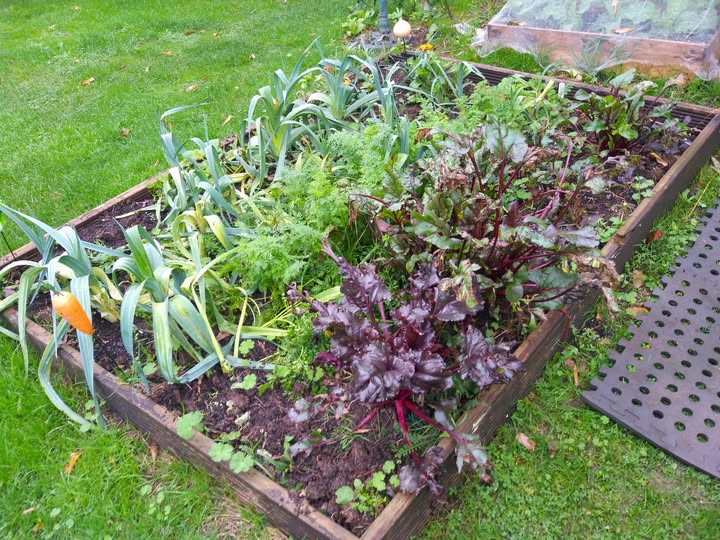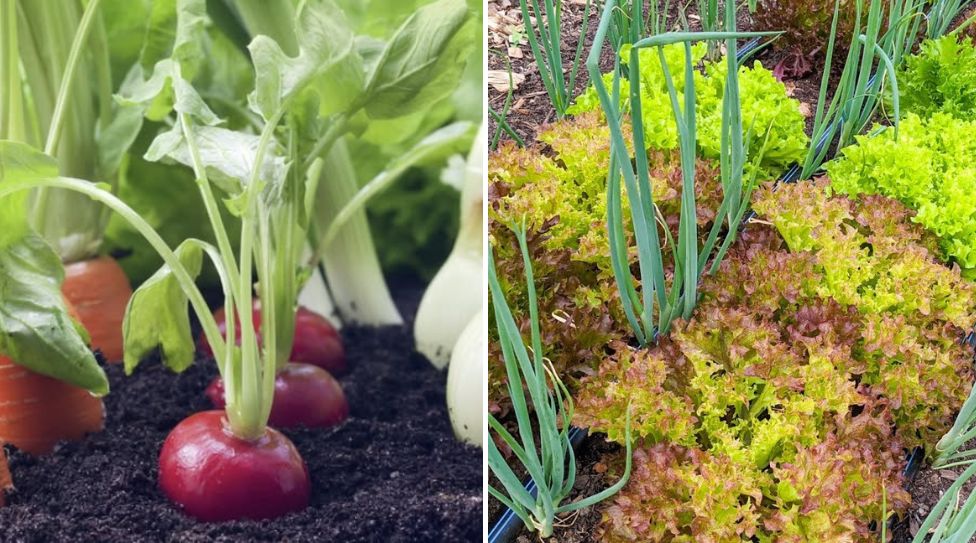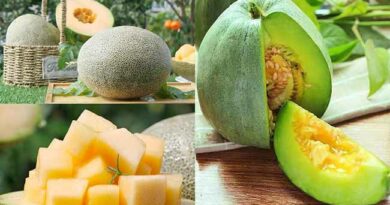Crops You Should Never Plant Together — They’ll Fight for Nutrients and Fail to Thrive
If you’ve been gardening long enough, you already know plants have personalities. Some are generous, some are dramatic, and some are downright territorial. And honestly, half of the issues people blame on “bad soil” or “too much sun” often come down to one super simple thing:
You planted the wrong neighbors together.
Plants interact underground way more than we realize. Their roots exchange chemicals, fight over food, send out warning signals, and sometimes even block growth of whoever’s too close. Once you understand that, the “mystery problems” in your garden suddenly look a lot less mysterious.
Here are the crops you should never grow side by side — and what to plant instead for way better results.
1. Tomatoes and Potatoes
These two look like they should get along — they’re both nightshades, they eat the same stuff, they grow fast — but that’s the exact problem.
Why they clash:
- They pull identical nutrients from the soil, especially potassium and phosphorus.
- They attract the same pests, like Colorado potato beetles and tomato fruitworms.
- They share weaknesses… especially late blight, which can jump from one to the other practically overnight.
- Potatoes grow aggressively underground, disturbing the soil tomato roots need to stay stable.
If you’ve ever wondered why your tomatoes suddenly stalled for no reason, check whether potatoes were anywhere nearby. The competition underground is intense — like two toddlers fighting over one cookie.
Better pairings:
Tomatoes love basil, carrots, and garlic.
Potatoes prefer beans, cabbage, and corn.
2. Onions and Beans
This is one of those invisible battles you don’t notice until the plants stop thriving.
Why they clash:
- Onions release sulfur-like compounds into the soil that legumes hate.
- Beans rely on nitrogen-fixing bacteria on their roots — but onion chemistry slows those bacteria down.
- Beans grow better in wide, airy soil… onions grow in clumps and restrict space.
If your beans ever looked weirdly sluggish while your onions were thriving, yeah — they were probably sabotaging each other the whole time.
Better pairings:
Onions do best with carrots, beets, and leafy greens.
Beans love corn, cucumbers, and strawberries.
3. Carrots and Dill
These two look similar, but dill has a sneaky side.
Why they clash:
- Mature dill releases chemicals that interfere with carrot root formation.
- Young dill is fine — but once it bolts, it starts suppressing whatever’s beside it.
- Dill’s taproot grows deeper than people think and steals water from carrot seedlings.
I once planted dill beside carrots because it looked “cute,” and my carrots came out shaped like tiny forked trees. Pretty? Maybe. Edible? Barely.
Better pairings:
Carrots love chives, onions, and leeks.
Dill grows great beside cabbage and cucumbers.
4. Corn and Tomatoes
I know people see this combo and think “That looks harmless.” It’s not.
Why they clash:
- Both are mega heavy feeders, meaning the soil gets drained fast.
- Corn shoots up fast and shades tomatoes during the most important growth window.
- They share the same worms — and one infestation spreads instantly.
- Corn’s big root system dominates everything around it.
If you’ve ever had tomatoes that looked starved no matter how much you fed them, this pairing may be why.
Better pairings:
Corn thrives with beans and squash.
Tomatoes love basil, parsley, and garlic.
5. Cucumbers and Potatoes

This one is subtle but important.
Why they clash:
- Potatoes aggressively strip potassium from soil — cucumbers desperately need potassium to fruit.
- Both are vulnerable to similar fungal diseases (especially early blight).
- Potato roots disturb cucumber vines when you dig or hill potatoes.
Cukes often end up pale, weak, and slow-growing if a potato patch is nearby. It’s not you — it’s them.
Better pairings:
Cucumbers love radishes, dill, beans.
Potatoes do great with cabbage and corn.
6. Brassicas and Strawberries
This includes cabbage, kale, broccoli, cauliflower — the whole crew.
Why they clash:
- Brassicas release compounds that slow strawberry root expansion.
- Strawberries harbor soil fungi that brassicas are super sensitive to.
- Their nutrient needs completely conflict — one wants nitrogen, one wants rich organic material.
If your strawberry patch has been “mysteriously” struggling? Check if cabbage lived there last season.
Better pairings:
Brassicas love onions, dill, and beets.
Strawberries enjoy beans, spinach, and lettuce.
7. Peppers and Beans
This combo looks innocent… until the peppers stop growing.
Why they clash:
- Peppers are heavy feeders and need loads of nutrients.
- Beans fix nitrogen — but they store most of it for themselves until the end of their life cycle.
- Beans grow fast and shade peppers without meaning to.
Peppers end up small, stressed, and barely fruiting.
Better pairings:
Peppers love basil, onions, and carrots.
Beans grow beautifully with corn and cucumbers.
8. Sunflowers and Potatoes
Sunflowers are gorgeous but kinda ruthless.
Why they clash:
- Sunflowers release strong allelopathic chemicals that slow potato tuber development.
- Both drink huge amounts of water — way more than most gardeners expect.
- Sunflower roots dominate more space underground than their stems suggest.
If potatoes come out tiny or irregular, check if sunflowers were nearby last season.
Better pairings:
Grow sunflowers on the edges of your garden.
Potatoes thrive with beans and cabbage.
9. Fennel and… Pretty Much Everything
Fennel is the loner of the garden world.
Why it clashes with almost all crops:
- It releases powerful chemicals that block seed germination nearby.
- Its deep root pulls nutrients from far distances.
- The soil around fennel becomes “fennel-biased” — not friendly to veggies.
It’s not a team player. Give it a pot or its own bed.
10. Beans and Garlic (or Onions)
This is another “quiet conflict.”
Why they clash:
- Garlic and onions interrupt nitrogen-fixing bacteria on bean roots.
- Beans need rich soil to form pods — alliums keep tightening it.
- Alliums grow downward aggressively, disturbing bean root zones.
The result? Yellow bean leaves and sad-looking pods.
Better pairings:
Garlic loves lettuce and carrots.
Beans thrive with corn and squash.
Designing a Healthy Garden Layout
Avoiding bad plant pairings is honestly just the beginning. Once you start paying attention to root behavior, nutrient timing, and how plants “talk” to each other, the whole layout of your garden feels different — almost like you’re arranging a tiny neighborhood where every resident has weird but predictable habits.
I used to cram things wherever I had space, and yeah… it looked fine for two weeks. Then the tomatoes bullied everything, the beans flopped over their neighbors, and the soil got so unevenly drained it felt like gardening on a sponge.
So here’s the layout strategy that actually works — the version you figure out after seasons of trial, error, and a couple of “why is everything yellow” garden meltdowns.
1. Group Plants by Nutrient Needs
I know this sounds basic, but the difference it makes is ridiculous. Plants with similar appetites behave better together — they draw down the soil at the same rhythm instead of stealing each other’s dinner.
Heavy feeders
Tomatoes, corn, cabbage, peppers
These guys act like bodybuilders at a buffet — nonstop nitrogen, potassium, the whole menu. If you put them side by side, they’ll drain the soil so hard you’ll feel it in your wallet. I now space them out and toss compost around them like confetti.
Light feeders
Carrots, beets, onions
They’re polite. They’ll whisper “excuse me” as they take nutrients. They won’t mind living close, and they don’t tank the soil for next season.
Nitrogen fixers
Beans, peas
They’re the gardeners of the garden — pulling nitrogen from the air and “storing” it in nodules. Rotate them through beds like free fertilizing machines.
What I learned the hard way:
If you mix these groups randomly, you’ll get weird nutrient imbalances. One year I planted broccoli next to beans and ended up with broccoli so leafy it looked like an ornamental shrub — zero heads. That’s when I started paying attention.
2. Rotate Crops Annually
Some people treat garden beds like furniture — once they find a nice spot, nothing ever moves. But plants are drama queens. If you grow the same family in the same place year after year, they basically invite every pest and fungal disease back to their old address.
Rotation gives the soil time to recover, especially if:
- the previous crop was a nutrient-hog,
- the soil structure got compacted, or
- the pests threw a party and laid eggs everywhere.
I follow the simple “roots → leaves → fruits → legumes” rotation. Not perfect, but enough to stop repeating last year’s mistakes.
3. Use Companion Planting (the pairings that actually help)
Some pairings feel like gardening magic. These combos make plants taste better, grow stronger, or just keep pests from staging a coup.
Carrots + onions
They don’t love each other romantically, but they do act like a security team. Carrots mask the smell of onions; onions confuse carrot flies. Lovely dysfunctional duo.
Tomatoes + basil
This one is famous for a reason. Basil legitimately improves tomato flavor — no one knows exactly why, but gardeners swear by it. Also, the smell drives pests crazy (in a good way).
Corn + beans + squash
Pretty much the most iconic plant friendship:
- beans feed corn,
- corn holds beans,
- squash shades soil like a living mulch.
The Three Sisters are old-school brilliance.
But companion planting isn’t magic. It’s solidarity. And sometimes, the little changes (like sticking marigolds near tomatoes) make the whole garden feel calmer.
4. Space Plants Properly
Even friendly plants get cranky when they’re elbow-to-elbow. Overcrowding is honestly the sneakiest cause of bad harvests — it mimics drought, nutrient deficiency, and disease all at once.
If you’ve ever wondered why your seedlings looked “okay” but suddenly stopped growing… yeah. They were suffocating.
The trick is to think about:
- root width (tomatoes spread way wider than you think),
- airflow (especially for powdery mildew-prone plants like cukes),
- mature size (never trust the tiny seedling — it’s lying).
I once planted zucchini and cucumbers 12 inches apart. Within a month, it looked like a botanical brawl. Never again.
Signs Your Plants Are Competing (You asked me to expand this — here’s a rich, detailed version)
Most plant drama happens underground, so you have to read the clues. And trust me, plants will start showing their frustration.
1. Slow, stubborn growth — even with good soil
If two plants are wrestling under the soil for nutrients, they’ll hit a weird “stall” phase.
You’ll think: I swear you were growing last week.
They weren’t — they were negotiating who gets the nitrogen.
2. Yellowing between the veins
This usually shows up in heavy feeders. It’s basically the plant saying:
Someone is drinking MY nutrients.
3. Oddly small leaves or short internodes
When roots are cramped or starved, plants shrink their leaves as a survival strategy.
It’s the plant version of budgeting.
4. One plant thriving while the other looks miserable
Competition rarely affects plants equally.
If one looks like a jungle gym and the other looks like a hostage, they’re competing.
5. Wilt that doesn’t improve after watering
This one is sneaky.
When roots are crowded, they can’t absorb water fast enough — even if the soil is perfectly moist.
6. Plants leaning or stretching away from each other
They’re literally trying to escape into better territory.
I have a pepper plant right now trying to exit the bed because a squash vine won’t stop shading it.
7. Roots circling or tangling when you dig them up
If you gently pull out an underperforming plant and the roots look like a knotted ball, that bed was overcrowded — or a neighbor was too aggressive.
8. Soil dries unevenly
Heavy-rooted plants (corn, potatoes, sunflowers) pull water from deeper layers.
Shallow plants (lettuce, onions) get drought-stressed even if the surface looks fine.
9. Blossoms dropping for no reason
Competition stresses fruiting plants fast.
Tomatoes and peppers especially respond by dropping flowers like dramatic toddlers.




